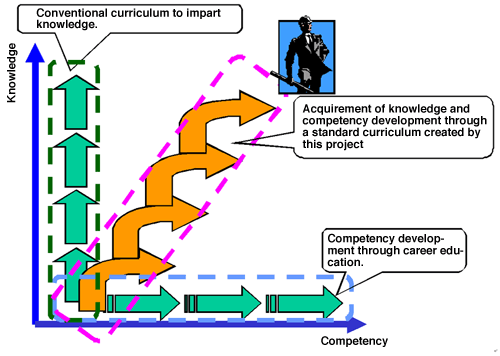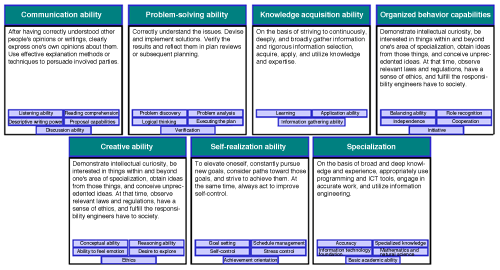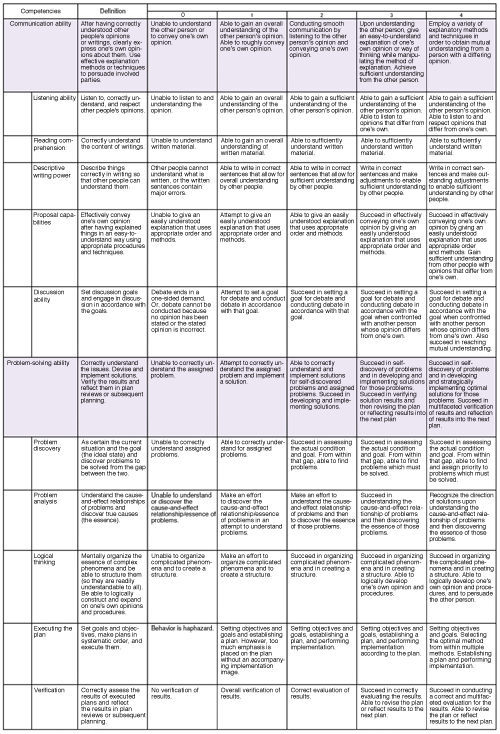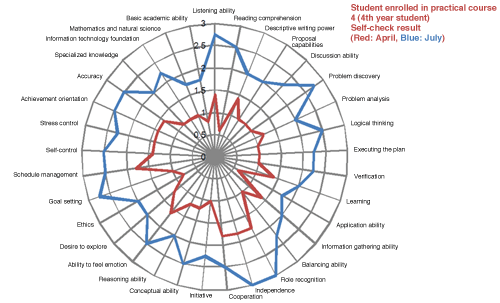Top>Education>Seeking Education for Assuring "Knowledge" and "Ability" through Competency Development - Human Resource Development in Science and Engineering: selected as a new Education GP by the MEXT -
 Index
Index
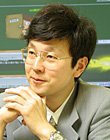
Mitsunori Makino [Profile]
Seeking Education for Assuring Knowledge and Ability through Competency Development
- Human Resource Development in the Faculty of Science and Engineering: selected as a new Education GP by the MEXT -
Mitsunori Makino
Professor of Systems Analysis, Visualization and Computer Graphics,
Faculty of Science and Engineering, Chuo University
The stern (?) eye of society at higher education
Recently, a stern eye has been cast upon the higher education of our country, including universities. Long gone is the so-called bubble period, when a great fuss was made over guaranteed success that came with graduating from a major university. Resolute effort is expected from current university students, who are part of a generation that was born around the end of the bubble period or after the bubble had burst.
In order to become professionals who will support our country and the entire world (whether or not this goal is met depends on the intention and fate of the student in question), university students are expected to absorb the required (perceived as required) knowledge and to acquire methods for utilizing such knowledge. However, society is becoming ever more diverse and advanced, and there have been changes to the content of elementary and secondary education that is received from the elementary school to high school level. As a result, the knowledge which students are expected to learn at university has reached unprecedented levels of breadth and depth. Conversely, the standard 4 year period of university education remains unchanged. Therefore, there is the possibility that university education is being crammed and condensed, and that educational content is failing to reach the previously satisfied standards. Of course, it is impossible to teach all required knowledge at universities, and this fact results in the idea that it is enough to provide an opportunity for study. Even so, to what extent and in what way should education be conducted at universities? To what extent should students acquire the ability to study? When answering such questions, it is important to enable students to find employment in the increasingly competitive industries of our country and to prepare students to survive as individuals in a constantly competitive society.
Quality assurance for education
Within this situation, there are numerous debates regarding how the quality of higher education can be guaranteed. A common theme among these debates is the emphasis on the ability to utilize knowledge gained from higher education, rather than on the knowledge itself.
For example, consider a report issued in December of 2008 by the Central Council for Education, an institution which is part of the Ministry of Education, Culture, Sports, Science and Technology (MEXT). The report, which is entitled Towards the Construction of Education in Bachelor Degree Programs, shows what is commonly known as academic ability (MEXT Homepage![]() ). In this case, graduate attributes is defined as the educational outcomes which should be commonly sought by bachelor programs (an educational program that confers the degree of bachelor). The report gives an example that is composed from the 4 categories of knowledge/understanding, versatile skills, attitude/orientation and overall educational experience and creative thinking ability. Another example is the "Fundamental Skills for Members of Society" as defined by the Ministry of Economy, Trade and Industry (METI) (METI Homepage
). In this case, graduate attributes is defined as the educational outcomes which should be commonly sought by bachelor programs (an educational program that confers the degree of bachelor). The report gives an example that is composed from the 4 categories of knowledge/understanding, versatile skills, attitude/orientation and overall educational experience and creative thinking ability. Another example is the "Fundamental Skills for Members of Society" as defined by the Ministry of Economy, Trade and Industry (METI) (METI Homepage![]() ). This system presents the required skills for working at a company or in regional society by using a total of 12 elements to classify the 3 abilities of action, thinking and teamwork. Additionally, in accordance with increased international movement of individuals, it is no longer unusual for a person's country of birth, country of education and country of employment to differ in one or all areas. Based on this fact, "Guidelines for Quality Provision in Cross-Border Higher Education" have been jointly announced by UNESCO and the OECD (OECD Homepage (PDF file)
). This system presents the required skills for working at a company or in regional society by using a total of 12 elements to classify the 3 abilities of action, thinking and teamwork. Additionally, in accordance with increased international movement of individuals, it is no longer unusual for a person's country of birth, country of education and country of employment to differ in one or all areas. Based on this fact, "Guidelines for Quality Provision in Cross-Border Higher Education" have been jointly announced by UNESCO and the OECD (OECD Homepage (PDF file)![]() ). These guidelines promote the development of high-quality higher level education that exceeds borders. Furthermore, in addition to realizing the maximum benefit in regards to the internationalization of higher level education, the guidelines also aim to protect students and other interested parties form low-quality education and invalid educational providers. In other words, it is expected that it will become normal in the near future for Japanese universities to undergo direct and indirect checks in order to ensure that the education provided is of sufficient quality even when viewed from international standards.
). These guidelines promote the development of high-quality higher level education that exceeds borders. Furthermore, in addition to realizing the maximum benefit in regards to the internationalization of higher level education, the guidelines also aim to protect students and other interested parties form low-quality education and invalid educational providers. In other words, it is expected that it will become normal in the near future for Japanese universities to undergo direct and indirect checks in order to ensure that the education provided is of sufficient quality even when viewed from international standards.
The academic ability used to question educational outcomes is more than the mere knowledge expressed through questions such as "What is being taught?" and "What is being studied?" Rather, graduate attributes extend to the behavioral characteristics of students themselves and is expressed through questions such as "What is the actual extent of understanding?""Can understanding be applied?" and "Has the required foundation been prepared for application of understanding?" In other words, in order to guarantee academic ability, it is necessary for students to give further consideration to the questions of "What must I know in order to become a professional in this field in the future?" and "What must I become capable of doing?" The method of students studying through observation (display) of the teacher will contribute significantly to the acquirement of graduate attributes by changing the consciousness of students who are accustomed to being taught so that the students will now take the initiative to conduct their studies. Also, in order to fulfill explanatory responsibility in regards to quality assurance, it is necessary to clearly show the establishment and development of a system for graduate attributes.
Competency development project of Chuo University, Faculty of Science and Engineering
The word competency refers to a portion of behavioral characteristics that utilize (are capable of utilizing) knowledge for the purpose of a certain objective. Potential ability and behavioral attributes in a broad sense are based upon the living environment, experiences and beliefs which have surrounded a person from the past to the present. Therefore, it is difficult to directly evaluate or teach such attributes. However, it is considered possible to roughly assess and conduct reforms for the behavioral characteristics during the work of a professional. For this reason, some corporations use competency as an evaluation standard when interviewing candidates. Also, after an employee has entered a company, there are cases in which competency checks are performed for that employee and surrounding coworkers, and in which competency is used to determine deployment of personnel. Incidentally, there is no such thing as an individual that possesses absolutely no competency. Therefore, the correct phrasing when encouraging reform would be "improve your communication ability", not "acquire communication ability".
As part of job-seeking support, Chuo University and many other universities perform competency development as part of "career support". It is important to provide career support in order to develop fundamental skills as a member of society. However, in order to develop graduate attributes, response is also required from the educational program (curriculum) which is an essential aspect of universities. (For example, even if career support is used to improve competency, a student cannot graduate if the required number of credits is not acquired.) For this reason, the ideal form for the systematic and active improvement of students is a combination of conventional education that imparts knowledge and education that develops human ability. (Figure 1)
Therefore, as part of education reform activities, the Chuo University Faculty of Science and Engineering has decided to start the development and implementation of an educational system for systematic competency development. The system was started from the Department of Information Science and Engineering in the 2008 academic year. Firstly, the department has created a more specific definition of the professional image that is expected from graduates of the department. Then, a definition was set for 7 competency items required for the professional image. Next, the 7 competency items were carefully refined into a total of 33 keywords (Figure 2). Since it was possible to broadly interpret the standards which were defined at this point, each keyword was divided in 5 stages (in other words, 165 items!) in order to create an achievement level check list (also known as a rubrics) (Figure 3). In order to formulate this list, young and mid-career instructors voluntarily returned their summer vacations and conducted intensive debate while receiving cooperation from personnel development professionals of corporations. This formulation process significantly increased the consciousness of participating instructors towards education and was also valuable as faculty development (FD). As a result, it was decided to implement from the 2009 academic year education which supports the major portion of competency development and checking. A practical course that seeks to develop image contents engineers (team-based projects raising the theme of CG and image processing, fields which are of great interest to students in the Department of Information Science and Engineering and fields which created visible results) was opened and classes are currently being held. When designing the practical course, the first step was to establish a class plan as a normal specialized course. Next, clear indication was given for the actions and submitted works which are expected from students at each class. Then, from those actions and submitted works, a relationship was created with competency keywords that can be checked. As a result, it was possible to conduct planning and implementation so that the practical course process created a strong consciousness towards competency in both instructors and students. For example, an opportunity was established during the final stage to allow for explanation of project results to individuals from outside of the university and to hold a Q&A session, and efforts were made to improve presentation and communication ability. These results are strongly indicated in the competency self-check results performed by students at the start of the first-term practical course in April and the end of the course in July (Figure 4).
Improvement in educational ability through development of graduate attributes
Using this project of the Department of Information Science and Engineering as a leading example, systematic competency development and checks were smoothly implemented into the curriculums of each department within the Faculty of Science and Engineering. This Systematic Competency Development & Education System, which seeks to clarify the graduate attributes of science and engineering at Chuo University, was selected by the MEXT as a Project to Promote University Education & Student Support [Theme A]: University Education Promotion Program for the 2009 academic year (selection rate of 14.8%). According to the selection judgment result, it can be inferred that there are strong expectations for this project to become an example of GP (Good Practice) for other universities.
Education that is conscious of competency development is exposed to questions regarding not only the competency of students, but also regarding the continual reform system (PDCA cycle) of the teaching side (faculty, staff, teaching assistants, etc.) and the competency of the teaching side itself. For this reason, this project includes faculty development and staff development. It also provides an opportunity to clarify what teaching assistants accomplish, as well as what means they should use and where they should direct their consciousness. I hope that this project creates a win-win relationship in which the guarantee and improvement of science and engineering at Chuo University will lead to the continual improvement of graduate attributes within science and engineering at Chuo University.
- Mitsunori Makino
Professor at the Department of Information and Systems Engineering in the Faculty of Science and Engineering
Project Leader of the "Program for Systematic Competency Development & Education" - Born in Chiba Prefecture in 1964. Graduated from the Waseda University School of Science and Engineering in 1987. In 1992, completed the Doctoral Program at the Waseda University Graduate School of Science and Engineering. Hold his Ph.D. in science and engineering. Assumed his current position in 2004 after serving as an Assistant Instructor and Assistant Professor at Chuo University. His current research themes include computer graphics, virtual reality and visualization. His research policy is to "construct a system for creating images which are useful to people and society, rather than images which are simply beautiful to view". In addition to his achievements in scholastic fields, he is actively involved in the development of science and engineering personnel, as well as the accreditation of education. Serves as Vice-Chairman of the Japan Accreditation Board for Engineering Education, Vice-Chairman of the Accreditation Council for the Institute of Electronics, Information and Communication Engineers, and as a member of the Working Group to Examine Policies for the Strengthening of High-Level Scientific Technology Personnel Development at Graduate Schools at the Expert Panel on Basic Policy Promotion, Council for Science and Technology Policy, Cabinet Office, Government of Japan. Has served as Assistant Director of the Faculty of Science and Engineering since November 2009.
- Makino Laboratory Webpage

- Research Activities as a Member of Research Fellowship for Young Scientists (DC1), Japan Society for the Promotion of Science (JSPS) Shuma Tsurumi
- Important Factors for Innovation in Payment Services Nobuhiko Sugiura
- Beyond the Concepts of Fellow Citizens and Foreigners— To Achieve SDGs Goal 10 “Reduce Inequality Within and Among Countries” Rika Lee
- Diary of Struggles in Cambodia Fumie Fukuoka
- How Can We Measure Learning Ability?
—Analysis of a Competency Self-Assessment Questionnaire— Yu Saito / Yoko Neha - The Making of the Movie Kirakira Megane








